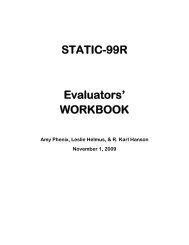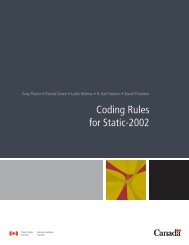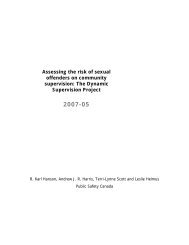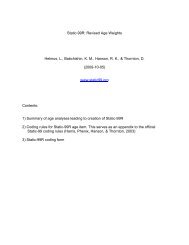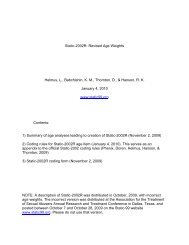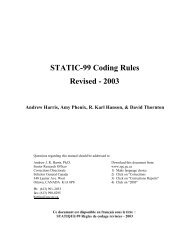Age coding for STATIC-99R
Age coding for STATIC-99R
Age coding for STATIC-99R
Create successful ePaper yourself
Turn your PDF publications into a flip-book with our unique Google optimized e-Paper software.
<strong>Age</strong> <strong>coding</strong> <strong>for</strong> <strong>STATIC</strong>-<strong>99R</strong><br />
August 20, 2012<br />
1. <strong>Age</strong> at Release from Index Sex Offence<br />
The Basic Principle: The rates of almost all crimes decrease as people age (Hirschi &<br />
Gottfredson, 1983; Sampson & Laub, 2003). Sexual offending does not appear to be<br />
an exception. Most studies have found that older sexual offenders are lower risk to<br />
reoffend than younger sexual offenders (Barbaree & Blanchard, 2008; Hanson, 2002,<br />
2006). Research has found that the original Static-99 did not fully account <strong>for</strong> age at<br />
release and that a new age weighting improved the predictive accuracy (Helmus et al.,<br />
2012 1 ). With the new age weighting (used in this item), age at release from index sex<br />
offence no longer significantly contributed to the prediction of sexual recidivism. Similar<br />
results were found in subgroups of rapists and child molesters.<br />
In<strong>for</strong>mation Required to Score This Item: To complete this item the evaluator should<br />
confirm the offender’s birth date (from official records if possible) or have other<br />
knowledge of the offender’s age through collateral report or offender self-report. The<br />
evaluator would benefit from access to an official criminal record as compiled by police,<br />
court or correctional authority that identifies the date of release from the index sex<br />
offence.<br />
The Basic Rule: Score -3 to 1 point depending on the age of the offender when they<br />
are released from their index sex offence referencing the table below.<br />
<strong>Age</strong> Score<br />
18 to 34.9 1<br />
35 to 39.9 0<br />
40 to 59.9 -1<br />
60 or older -3<br />
Under certain conditions, such as anticipated release from custody, the evaluator may<br />
be interested in an estimate of the offender’s risk at some specific time in the future<br />
such as <strong>coding</strong> the Static-<strong>99R</strong> in pre-sentencing situations. Static-<strong>99R</strong> may be scored<br />
months be<strong>for</strong>e the offender’s release to the community and the offender may advance<br />
an age scoring category by the time he is released. For assessing risk in the future,<br />
consider what his age will be on the date of release from the index sex offence. In this<br />
case, you calculate risk based upon age at exposure to risk.<br />
1 Helmus, L., Thornton, D., Hanson, R.K., & Babchishin, K.M. (2012). Improving the predictive accuracy of Static-99<br />
and Static-2002 with older sex offenders: Revised age weights. Sexual Abuse: A Journal of Research and<br />
Treatment, 24(1), 64-101. doi:10.1177/1079063211409951
<strong>Age</strong> <strong>coding</strong> <strong>for</strong> <strong>STATIC</strong>-<strong>99R</strong><br />
August 20, 2012<br />
Sometimes the offender’s release date may be uncertain. For example, he may be<br />
eligible <strong>for</strong> parole but does not qualify <strong>for</strong> release due to an inadequate release plan. In<br />
these cases it may be appropriate to use some <strong>for</strong>m of conditional wording indicating<br />
how his risk assessment would change with a delayed release date.<br />
Note that in some cases, the index sex offence identified <strong>for</strong> Static-<strong>99R</strong> scoring<br />
purposes may not be the same as the offender’s current offence. For example,<br />
sometimes an offender is serving a sentence <strong>for</strong> a non-sexual offence but they are<br />
assessed as a sex offender due to a prior sexual offence. Because this item is scored<br />
using the age at release from the index sex offence rather than age of release from the<br />
current offence, the offender may now be significantly older than when they were<br />
released from their index sex offence. For example, an offender may be released from<br />
custody on their index sex offence at age 35 and they may be released at age 55 from a<br />
current prison term after committing a non-sexual offence. In these cases where an<br />
offender had committed subsequent non-sexual offences and is now much older, the<br />
effect of aging on sexual recidivism (as well as their continued criminality after the index<br />
sex offence) will need to be considered outside the Static-<strong>99R</strong>.



